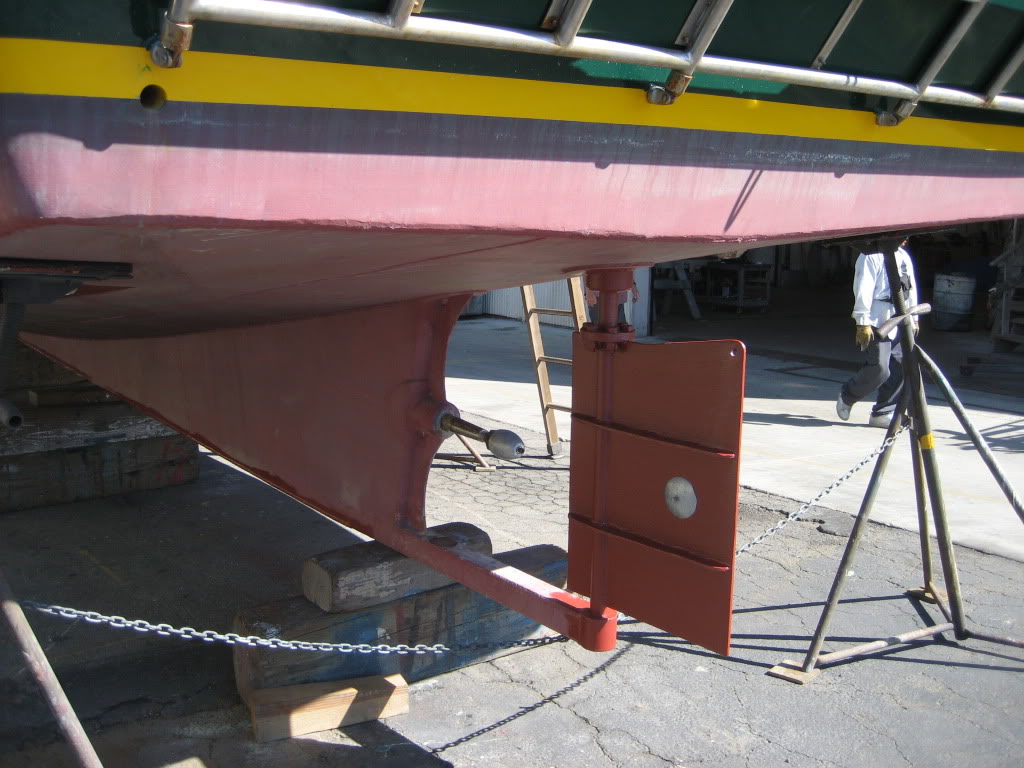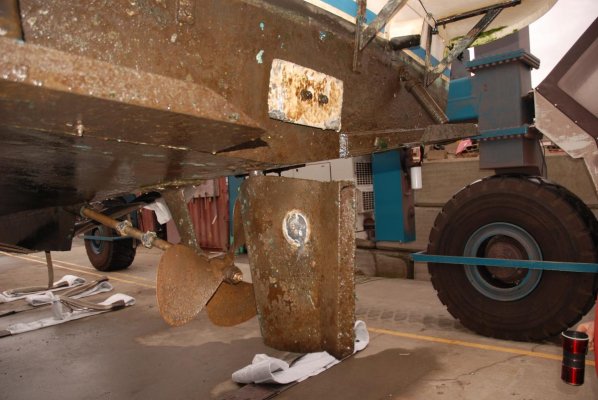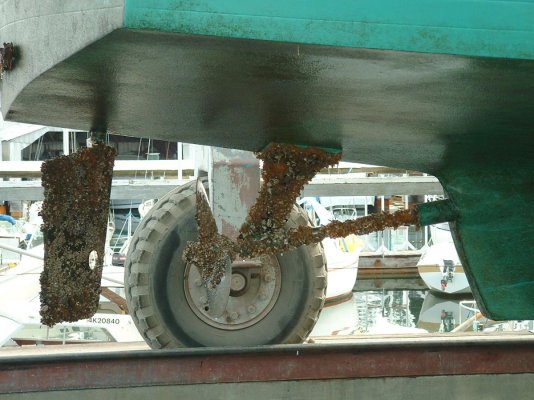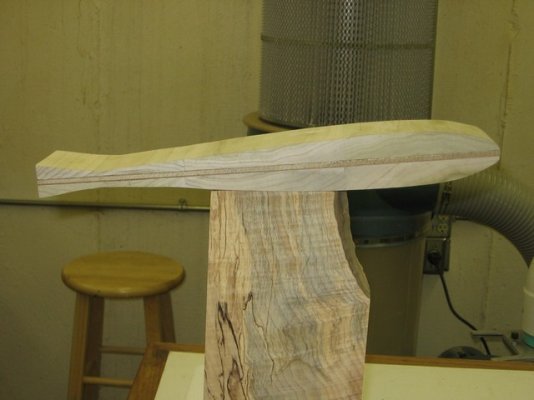I have a 1974 fiberglass Grand Banks 32. The rudder stops are set at 16 degrees from dead center. Want to improve forward turning efficiency when low speeds manuevering. Can I get better performance to increasing maximum angle stop and if so, to what angle? Does this create over issues, or concerns? I have read that generally a rudder can be deflected 35 degrees before it starts to stall. Does anyone have specific experience this issue with the GB 32 or other full keel semi deplacement trawler which they are willing to share?
You are using an out of date browser. It may not display this or other websites correctly.
You should upgrade or use an alternative browser.
You should upgrade or use an alternative browser.
Rudder Angle Maximum for GB 32
- Thread starter Zambezi
- Start date
The friendliest place on the web for anyone who enjoys boating.
If you have answers, please help by responding to the unanswered posts.
If you have answers, please help by responding to the unanswered posts.
Steve
Guru
Several Monk 36 owners have modified their rudders by welding a "fishtail" vertically on the trailing edge usually just a piece of 2" SS angle the piont of the angle welded to the edge of the rudder. They are very happy with the results claim much better handling especially at slow speeds. I have not done it but may in the future.
Steve W
Steve W
Conrad
Guru
- Joined
- Oct 19, 2007
- Messages
- 1,972
- Location
- Canada
- Vessel Name
- Blue Sky
- Vessel Make
- Nordic Tugs 42 Hull #001
Several Monk 36 owners have modified their rudders by welding a "fishtail" vertically on the trailing edge usually just a piece of 2" SS angle the piont of the angle welded to the edge of the rudder. They are very happy with the results claim much better handling especially at slow speeds. I have not done it but may in the future.
Steve W
The PO of our Ennos Sapphire 32 did exactly that to the rudder, after experiencing poor low speed handling. I can't say what it was like before, but it seems okay now.
He apparently was advised by Bill Garden, who suggested that the angle of the fishtail be about 17 degrees.
rochepoint
Guru
- Joined
- Apr 4, 2009
- Messages
- 1,747
- Location
- Sidney BC, Canada
- Vessel Name
- Roche Point
- Vessel Make
- 1985 Cheer Men PT38 Sedan
Conrad do you have any photos of this?
Giggitoni
Guru
- Joined
- Jun 21, 2008
- Messages
- 2,092
- Location
- United States
- Vessel Name
- Mahalo Moi
- Vessel Make
- 1986 Grand Banks 42 Classic
I have a 1974 fiberglass Grand Banks 32. The rudder stops are set at 16 degrees from dead center. Want to improve forward turning efficiency when low speeds manuevering. Can I get better performance to increasing maximum angle stop and if so, to what angle? Does this create over issues, or concerns? I have read that generally a rudder can be deflected 35 degrees before it starts to stall. Does anyone have specific experience this issue with the GB 32 or other full keel semi deplacement trawler which they are willing to share?
I suggest you post your question to Bob Lowe on The GB Owners Board on Grand Banks Owner's Resources.
Last edited:
Nomad Willy
Guru
The rudder on my 30' Willard is stopped by the slave cylinder at 45 degrees. Works great. Turns really sharp at slow speeds and even has fairly good steerage in neutral gear. The Willard is a bit slower than a GB and has a smaller rudder so suspect 45 degrees would not be as effective as w the Willard but I'd try 35. I'd think 16 degrees would be WAY too little deflection.
Conrad
Guru
- Joined
- Oct 19, 2007
- Messages
- 1,972
- Location
- Canada
- Vessel Name
- Blue Sky
- Vessel Make
- Nordic Tugs 42 Hull #001
Conrad do you have any photos of this?
I was hoping nobody would ask, because the only one I have was taken just after the boat had been hauled, and the bottom looks pretty grotty!
Attachments
rochepoint
Guru
- Joined
- Apr 4, 2009
- Messages
- 1,747
- Location
- Sidney BC, Canada
- Vessel Name
- Roche Point
- Vessel Make
- 1985 Cheer Men PT38 Sedan
psneeld
Guru
The problem with just arbitrarily changing the stops is not knowing the why behind where they are now.
Displacement boats can have large rudder angles but planing/semi-planing usually have much smaller. Not sure what your GB32 is...is it powered high enough to be semi-planing?
If not...going up to 30-45 isn't out of the question but I would probably stick to the 35 guideline. If you are running 15 knots or higher sometimes....then I would definitely research some more.
Displacement boats can have large rudder angles but planing/semi-planing usually have much smaller. Not sure what your GB32 is...is it powered high enough to be semi-planing?
If not...going up to 30-45 isn't out of the question but I would probably stick to the 35 guideline. If you are running 15 knots or higher sometimes....then I would definitely research some more.
psneeld
Guru
I was hoping nobody would ask, because the only one I have was taken just after the boat had been hauled, and the bottom looks pretty grotty!
I'm guessing not much...but any "more definite" clues as to how much drag the fishtail adds?
Steve
Guru
The picture posted by Conrad is basically what some Monk owners have done, some have also added a plate about 3" wide welded on the top and bottom of the rudder to guide the prop thrust over the "fishtail".
Steve W
Steve W
honeybadger
Senior Member
- Joined
- May 20, 2012
- Messages
- 194
- Location
- USA
- Vessel Name
- HoneyBadger
- Vessel Make
- 1990 Harkers Island Trawler Typical wooden hull with a Carolina flare and no deadrise at the stern
Slower boats have the leading edge toward the prop called the balance it catches the thrust and diverts it to add control at slower speeds and angles. Also they are more of a square blocky looking Rudder, Go Fast boats have less rudder and no balance forward of the rudder shaft, This is for on plane turning with less drag if you had a displacment rudder on a semi planning boat and you turned the wheel it would be an agressive turn and spill your drink after the microwave bounced off the salon windows. Online i learned alot about this just google Rudder balance it explains loads and reasons and cause and effect !
psneeld
Guru
Slower boats have the leading edge toward the prop called the balance it catches the thrust and diverts it to add control at slower speeds and angles. Also they are more of a square blocky looking Rudder, Go Fast boats have less rudder and no balance forward of the rudder shaft, This is for on plane turning with less drag if you had a displacment rudder on a semi planning boat and you turned the wheel it would be an agressive turn and spill your drink after the microwave bounced off the salon windows. Online i learned alot about this just google Rudder balance it explains loads and reasons and cause and effect !
the original reason for a balanced rudder game long before hydraulics and power steering...it was all about the ease of holding that tiller.
but I can see where the emphasis is now on putting more rudder in front of the propwash.
Conrad
Guru
- Joined
- Oct 19, 2007
- Messages
- 1,972
- Location
- Canada
- Vessel Name
- Blue Sky
- Vessel Make
- Nordic Tugs 42 Hull #001
I'm guessing not much...but any "more definite" clues as to how much drag the fishtail adds?
Excellent question, but unfortunately I don't know, since the mod was done by the PO. When I'm back at the boat next month I'll go back through the log book and see if anything was mentioned. The PO did a lot of tuning - prop etc. - and kept good records, so there may be something there.
Nomad Willy
Guru
Increasing deflection increases drag not at all and increasing area increases drag very slightly compared to the wedge. No studies to back that up but I feel quite confident.
I have had an idea for a long time that rudder performance could be greatly increased by putting holes along the leading edge or possibly just behind the rudder shaft. Or both perhaps. The idea being that the hydraulics on the back side would benefit much the same way as slotted leading edges of aircraft wings .... Permits normal functioning at much higher angles of attack. Can't imagine an aircraft w big wedges on their trailing edges. I have a hunch too that many rudders on boats aren't very well thought out or researched.
Personally I would prefer a big rudder w power hydraulic steering but if one went in that direction one would/should consider all aspects of structural integrity before going down to the sea. A couple more inches TE on Willy's rudder w power steering would be GREAT.
I have had an idea for a long time that rudder performance could be greatly increased by putting holes along the leading edge or possibly just behind the rudder shaft. Or both perhaps. The idea being that the hydraulics on the back side would benefit much the same way as slotted leading edges of aircraft wings .... Permits normal functioning at much higher angles of attack. Can't imagine an aircraft w big wedges on their trailing edges. I have a hunch too that many rudders on boats aren't very well thought out or researched.
Personally I would prefer a big rudder w power hydraulic steering but if one went in that direction one would/should consider all aspects of structural integrity before going down to the sea. A couple more inches TE on Willy's rudder w power steering would be GREAT.
psneeld
Guru
At some speed...not sure what...it will definitely increase drag because the fishtail will stall and create turbulence. Again like I first said...not much but I'm curious. (It should be acting just like a spoiler on a jet wing..same shape)Increasing deflection increases drag not at all and increasing area increases drag very slightly compared to the wedge. No studies to back that up but I feel quite confident.
I have had an idea for a long time that rudder performance could be greatly increased by putting holes along the leading edge or possibly just behind the rudder shaft. Or both perhaps. The idea being that the hydraulics on the back side would benefit much the same way as slotted leading edges of aircraft wings .... Permits normal functioning at much higher angles of attack. Can't imagine an aircraft w big wedges on their trailing edges. I have a hunch too that many rudders on boats aren't very well thought out or researched.
Personally I would prefer a big rudder w power hydraulic steering but if one went in that direction one would/should consider all aspects of structural integrity before going down to the sea. A couple more inches TE on Willy's rudder w power steering would be GREAT.
RickH
Veteran Member
- Joined
- Apr 17, 2011
- Messages
- 35
Here's another take on the fishtail/thistle rudder:
Thistel Sandwich-Hold the Mayo.... | SailAngle.com
Low speed handling greatly improved and minimal cost (<$200)
RickH
Thistel Sandwich-Hold the Mayo.... | SailAngle.com
Low speed handling greatly improved and minimal cost (<$200)
RickH
Thanks everyone for your posts about the Thistle/fishtail rudders. I increased my maximum rudder angle from 15 degrees to 26 degrees which is about the maximum I can given the chain and cable steering system on my 1974 GB 32. This has shorten my low speed turning radius by half and I can almost do a 180 degree turn within a boat length. When I haul out later this year I plan to add a fishtail rudder to my flat-plate rudder. Does anyone has suggestions on the angle of the fishtail. Boat Mechanical Systems Handbook by Dave Gerr specifies 45 degrees.
markpierce
Master and Commander
- Joined
- Sep 25, 2010
- Messages
- 12,557
- Location
- USA
- Vessel Name
- Carquinez Coot
- Vessel Make
- penultimate Seahorse Marine Coot hull #6
The rudder on my 30' Willard is stopped by the slave cylinder at 45 degrees. Works great. Turns really sharp at slow speeds and even has fairly good steerage in neutral gear. The Willard is a bit slower than a GB and has a smaller rudder so suspect 45 degrees would not be as effective as w the Willard but I'd try 35. I'd think 16 degrees would be WAY too little deflection.
Yeah. Forty-five degrees works well with the slow Coot. Sixteen degrees might work with a speedboat, but not for a trawler.

RickH
Veteran Member
- Joined
- Apr 17, 2011
- Messages
- 35
Suggest that you order down Dave Gerr's article on rudders from Professional Boatbuilding. Go here: Professional BoatBuilder - #102 PBB Aug/Sept 2006
and you can get a PDF via email for under six bucks. He gives all sorts of good info, including plotting the fishtail based on rudder size.
RickH
and you can get a PDF via email for under six bucks. He gives all sorts of good info, including plotting the fishtail based on rudder size.
RickH
Nomad Willy
Guru
I just think kinky and dragy rudders aren't necessary or desirable. One just needs a big enough rudder and enough deflection.
FF
Guru
- Joined
- Oct 12, 2007
- Messages
- 22,552
Our boat was designed with a 1 1/2 gear reduction, 27 inch prop..
By time we bought her a PO had replaced the box with a 3-1 unit, so we installed a 32 inch prop to make up some of the difference.
As the rudder is for a launch it was way undersized with such a huge prop.
Even with a "backing rudder" (part of the origional install) the handeling was not great.
A pair of 2x2 SS angle iron bolted thru the trailing edge as a diamond is a big help at docking speeds.
Since we normal cruise at SL 1 (7K) , there is no loss from drag.
FF
By time we bought her a PO had replaced the box with a 3-1 unit, so we installed a 32 inch prop to make up some of the difference.
As the rudder is for a launch it was way undersized with such a huge prop.
Even with a "backing rudder" (part of the origional install) the handeling was not great.
A pair of 2x2 SS angle iron bolted thru the trailing edge as a diamond is a big help at docking speeds.
Since we normal cruise at SL 1 (7K) , there is no loss from drag.
FF
Last edited:
RickH
Veteran Member
- Joined
- Apr 17, 2011
- Messages
- 35
The 45 degree diamond configuration suggested will probably give you some sort of improvement, but here is a true "thistle" cross-section plotted from the Gerr article mentioned earlier. It's basically a modified airfoil with the fishtail on the trailing edge. Gerr also strongly recommends the use of end plates (on the top and bottom of the rudder) to help channel prop wash through the fishtail. The line through the middle on the pic is a scrap of 1/4 inch ply to represent the existing flat plate rudder (actually 5/16").
RickH
RickH
Attachments
psneeld
Guru
The 45 degree diamond configuration suggested will probably give you some sort of improvement, but here is a true "thistle" cross-section plotted from the Gerr article mentioned earlier. It's basically a modified airfoil with the fishtail on the trailing edge. Gerr also strongly recommends the use of end plates (on the top and bottom of the rudder) to help channel prop wash through the fishtail. The line through the middle on the pic is a scrap of 1/4 inch ply to represent the existing flat plate rudder (actually 5/16").
RickH
Having hundreds of hours of advanced aerodynamics I can really appreciate the thistle shape..owning a 6.5 knot trawler and I think the thistle shape for a rudder is a complete waste of energy...but I bet it looks really cool..

On most slow, highly manueverable tug boats I see all kinds of things like flanking rudders, kort nozzles, rotating drives...but never a thistle rudder....hmmmmm
Not saying they don't improve performance but I just can't believe it's even measurable...is it?
 any independent written comparisons?
any independent written comparisons?
Last edited:
RickH
Veteran Member
- Joined
- Apr 17, 2011
- Messages
- 35
I'm not one of those "I made it so it must be good" people. Our trawler (Sundowner Sea Tug) was a pig at slow speed, and only vague in it's response to helm inputs. I first read about the thistle on this forum and T&T and did some further research. You may find the boat owners quote in this article enlightening; http://navigatorpublishing.com/ondigital/ON188_download_edition.pdf
(It's a long 9 MB PDF download so be patient).
There was another website, "Mystic Rudder" which has since been pulled down as I believe the owner sold the boat ("Moose"). I have zero hours in advanced aerodynamics, and don't really care what shape it takes, the thistle improved low speed handling on our boat without having to resort to the standard bow/stern thruster route. And it did so at a very reasonable cost. As far as the "cool factor" there is none: you can't see the damn thing once the boat is launched. There may be other citations on Google or Bing. I just went with those two.
RickH
(It's a long 9 MB PDF download so be patient).
There was another website, "Mystic Rudder" which has since been pulled down as I believe the owner sold the boat ("Moose"). I have zero hours in advanced aerodynamics, and don't really care what shape it takes, the thistle improved low speed handling on our boat without having to resort to the standard bow/stern thruster route. And it did so at a very reasonable cost. As far as the "cool factor" there is none: you can't see the damn thing once the boat is launched. There may be other citations on Google or Bing. I just went with those two.
RickH
psneeld
Guru
I'm not one of those "I made it so it must be good" people. Our trawler (Sundowner Sea Tug) was a pig at slow speed, and only vague in it's response to helm inputs. I first read about the thistle on this forum and T&T and did some further research. You may find the boat owners quote in this article enlightening; http://navigatorpublishing.com/ondigital/ON188_download_edition.pdf
(It's a long 9 MB PDF download so be patient).
There was another website, "Mystic Rudder" which has since been pulled down as I believe the owner sold the boat ("Moose"). I have zero hours in advanced aerodynamics, and don't really care what shape it takes, the thistle improved low speed handling on our boat without having to resort to the standard bow/stern thruster route. And it did so at a very reasonable cost. As far as the "cool factor" there is none: you can't see the damn thing once the boat is launched. There may be other citations on Google or Bing. I just went with those two.
RickH
All I am saying is that maybe an inch or two more of sudder size would have done the same thing...
tweaking "shape" is bigger at over 15-20 knots hydrodynamically and pretty obvious from the Wright Flyer to supersonic flight....but at less than 10 knots I think size and shape are the same....so shape is more "technical" than actual...and as far as writers...they get paid to write articles wherther true or not...and without some independent testing..it's hard to say whether one (shape versus size) matters....
RickH
Veteran Member
- Joined
- Apr 17, 2011
- Messages
- 35
So, I guess that the real question is this: Based on your background and experience in aerodynamics, how would YOU empirically test a modicication such as this one? Inquiring minds would like your input.
RickH
RickH
psneeld
Guru
So, I guess that the real question is this: Based on your background and experience in aerodynamics, how would YOU empirically test a modicication such as this one? Inquiring minds would like your input.
RickH
Post 10 is where I asked if there was any hard data to be found...there's lots of tests that can be done...if I were a designer that wanted my designs to become popular...some expensive tank testing may be in order.
Me???? I wouldn't even bother as I'm pretty sure of my estimates....and having driven enough single screw boats...I know whether the boat has enough rudder for reasonable manuevering and whether a few more inches of area wold do the trick. It's high speed singles where I would turn to true professional design help if I was disatisfied with rudder performance..
FF
Guru
- Joined
- Oct 12, 2007
- Messages
- 22,552
Simple single screw test is to back at low speed for 1/4 mile.
If this is easily done , the rudder system is probably fine.
FF
If this is easily done , the rudder system is probably fine.
FF
Similar threads
- Replies
- 11
- Views
- 8K
- Locked
- Replies
- 7
- Views
- 5K
- Locked
- Replies
- 2
- Views
- 3K



